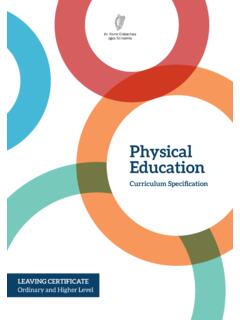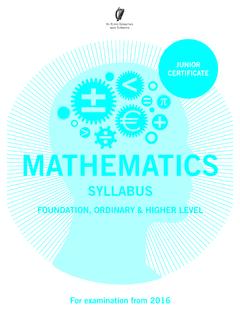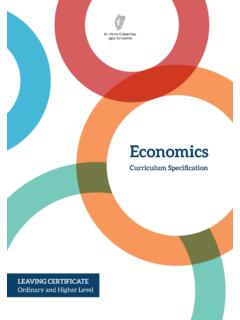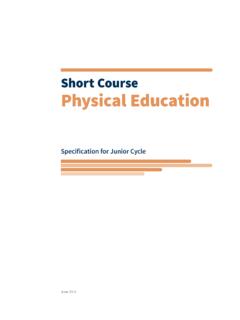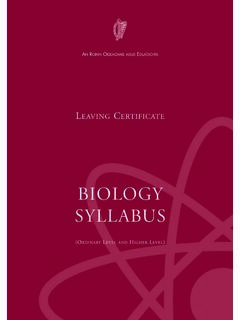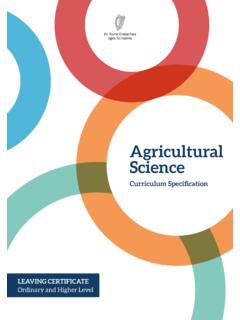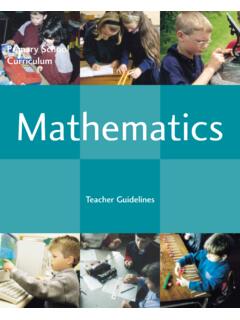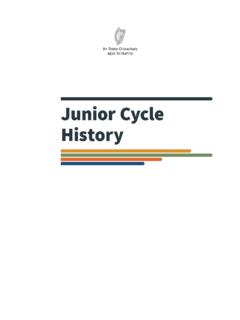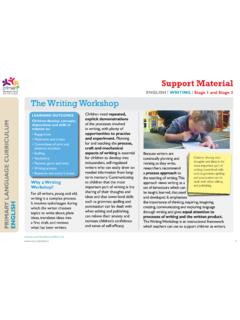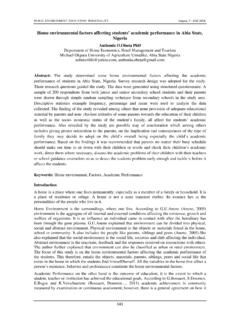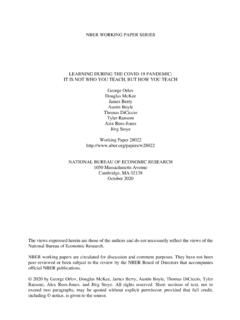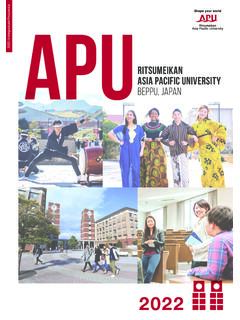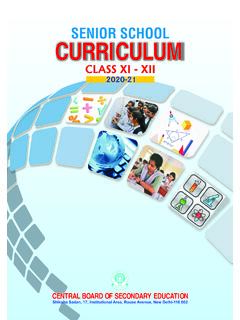Transcription of Junior Cycle Home Economics - Curriculum
1 Junior Cycle home Economics Contents Page 3 Introduction to Junior Cycle Page 4 Rationale Page 5 Aim Page 6 Overview: Links Statements of learning Junior Cycle home Economics and Key Skills Page 10 Overview: Course Continuity and Progression Page 18 Expectations for Students learning Outcomes Page 22 Assessment and Reporting Page 29 Appendix A Page 32 Appendix B. 3 Introduction to Junior Cycle Junior Cycle home Economics Introduction to Junior Cycle Junior Cycle education places students at the centre of the educational experience, enabling them to actively participate in their communities and in society and to be resourceful and confident learners in all aspects and stages of their lives. Junior Cycle is inclusive of all students and contributes to equality of opportunity, participation and outcome for all. The Junior Cycle allows students to make a greater connection with learning by focusing on the quality of learning that takes place and by offering experiences that are engaging and enjoyable for them, and relevant to their lives.
2 These experiences are of a high quality, contribute directly to the physical, mental and social wellbeing of learners, and where possible, provide opportunities for them to develop their abilities and talents in the areas of creativity, innovation and enterprise. The learner's Junior Cycle programme builds on their learning to date and actively supports their progress in learning and in addition, supports them in developing the learning skills that will assist them in meeting the challenges of life beyond school. 4. Junior Cycle Rationale home Economics Rationale The central focus of home Economics as a field of study is achieving optimal, healthy and sustainable living for individuals, families and society. Individuals and families in every society are continually faced with new and emergent issues that can impact on their wellbeing. Such issues include concerns relating to food, nutrition, diet and health; family and social concerns.
3 Consumer issues; sustainability in the home ; responsible family resource management; and textiles and clothing. In home Economics , students learn how to address these practical, real-world, perennial problems of individuals, families, households and society in socially responsible ways. Practical perennial problems or concerns are endured from generation to generation by families and require critical decision-making skills to resolve them. home Economics education uses a systems approach to empower individuals and families with the knowledge and skills to address these real-life concerns of everyday living. home Economics draws on diverse disciplines integrating social, physical and human sciences. It strives to solve everyday challenges using a blend of knowledge and skills acquired from multiple disciplines. home Economics education develops students' essential lifeskills and personal independence.
4 It supports the development of students who are critical, creative thinkers and encourages students to be problem-solvers capable of making ethically and socially responsible decisions. 5. Junior Cycle Aim home Economics Aim home Economics aims to develop students' knowledge, attitudes, understanding, skills and values to achieve optimal, healthy and sustainable living for every person as an individual, and as a member of families and society. Students develop practical food and health literacy skills so that they are enabled to adopt a healthy lifestyle and make informed decisions that positively impact their health and wellbeing as individuals as well as within their families and society. home Economics nurtures students' resourcefulness, innovation, adaptability, and competency as consumers. It develops students' creative design and textile skills. home Economics develops students who are environmentally conscious and dedicated to a sustainable and responsible way of life.
5 6. Junior Cycle Overview: Links home Economics Overview: Links home Economics supports a broad range of learning objectives at Junior Cycle . Tables 1 and 2. on the following pages show how Junior Cycle home Economics is linked to central features of learning and teaching in Junior Cycle . Table 1: Links between Junior Cycle home Economics and the statements of learning STATEMENTS OF learning . The statement Examples of relevant learning SOL 13: The student understands the Students will develop their food and health importance of food and diet in making literacy skills so that they make positive healthy lifestyle choices. lifestyle choices for themselves as individuals as well as within their families and society. SOL 10: The student has the awareness, Students will develop their critical thinking knowledge, skills, values and motivation and decision-making skills in order to live a to live sustainably.
6 Sustainable and responsible way of life. SOL 14: The student makes informed financial Students will develop their skills as discerning decisions and develops good consumer skills. consumers and demonstrate consumer competency when managing financial resources in the home . SOL 9: The student understands the origins and Students will reflect on and analyse the impacts impacts of social, economic , and environmental of products and processes in the home on aspects of the world around her/him. people, society and environments. SOL 11: The student takes action to safeguard Students will make informed decisions that and promote her/his wellbeing and that of impact his/her health, wellbeing and safety and others. that of others. SOL 22: The student takes initiative, is Students will develop their entrepreneurial innovative and develops entrepreneurial skills. skills as they seek to be innovative in dealing with life's challenges and opportunities.
7 SOL 23: The student brings an idea from Students will apply the design brief process in concept to realisation. textiles and food to take an idea from concept to realisation. 7 Key Skills In addition to their specific content and knowledge, the subjects and short courses of Junior Cycle Junior Cycle provide students with opportunities to develop a range of key skills. There are opportunities to home Economics support all key skills in this course but some are particularly significant. The examples below Overview: Links identify some of the elements that are related to learning activities in home Economics . Teachers can also build many of the other elements of particular key skills into their classroom planning. The eight key skills are set out in detail in Key Skills of Junior Cycle . The Junior Cycle Curriculum focuses on eight key skills: Being creative Being literate Being numerate Communicating Managing information and thinking Managing myself Staying well Working with others.
8 Key Skills of Junior Cycle Figure 1: Key skills of Junior Cycle 8 Developing my understanding and enjoyment of words and language Reading for enjoyment and with Junior Cycle critical understanding Knowing myself home Economics Writing for different purposes Making considered decisions Expressing ideas clearly and Overview: Links accurately Setting and achieving personal goals Developing my spoken language Being able to reflect on my own learning Exploring and creating a variety of texts, including multi-modal texts Using digital technology to manage myself and my learning Using language Using numbers Listening and expressing myself Performing and presenting BEING. Discussing and debating LITERATE. Using digital technology to communicate Being healthy and COMMUNICATING MANAGING physically active MYSELF Being social Being safe Being spiritual Being confident Developing good relationships and dealing WORKING.
9 WITH. OTHERS. KEY Being positive about learning SKILLS. with conflict Being responsible, safe STAYING and ethical in using Co-operating WELL digital technology Respecting difference Contributing to making the world a better place learning with others BEING. Working with others CREATIVE MANAGING Being curious through digital INFORMATION. & THINKING Gathering, recording, technology organising and evaluating BEING information and data NUMERATE. Thinking creatively and critically Reflecting on and evaluating my learning Imagining Using digital technology Exploring options and alternatives to access, manage and share content Implementing ideas and taking action Expressing ideas mathematically learning creatively Estimating, predicting and calculating Stimulating creativity using digital Developing a positive disposition technology towards investigating, reasoning and problem-solving Seeing patterns, trends and relationships Gathering, interpreting and representing data Using digital technology to develop numeracy skills and understanding 12914 NCCA Jr Cycle Key Skills Poster 1 10/06/2016 12:58.
10 Table 2: Links between Junior Cycle home Economics and key skills 9 Key skill Key skill element Student learning activity Being creative Exploring options and Students apply the design brief process in the making Junior Cycle home Economics alternatives of a textile item for the individual or the home . Overview: Links Implementing ideas and taking action Being literate Expressing ideas Students demonstrate the importance of effective clearly and accurately communication by making a complaint about a consumer issue by letter/email. Being numerate Developing a positive, Students apply their numerical skills in the disposition towards preparation of a budget; adapting recipe ingredients;. investigating, weighing and measuring out ingredients; room reasoning and planning; and measuring fabrics. problem-solving Estimating, predicting and calculating Communicating Discussing and Students will discuss family relationships and the role debating of communication in strengthening relationships.
